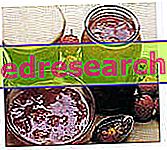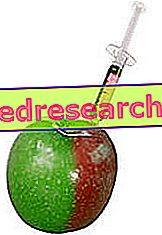Sugar: a natural preservative
The jam is a food product obtained by cooking the fruit pulp added with sugar;

- Products prepared with the pulp and / or puree of one or more fruits can be considered jams. More precisely, the jams must have no less than 35% of pulp and fruit; for extra jams the legal minimum of fruit pulp increases to 45%. For jams containing particular fruits such as rowanberries, sea buckthorn, cashew apple, etc. other percentages are indicated.
- The definition of jams is up to the products prepared by pulp, purée, juice, aqueous extracts and citrus fruit peel with a minimum of 20% fruit, of which at least 7.5% must come from the endocarp.
Sugar, the main ingredient along with fruit, is added with the dual purpose of improving organoleptic characteristics and increasing storage times. At this point a question could arise ... but how is it possible that sugar, the nutritional element par excellence of cells, including microbial ones, can inhibit their growth? To answer this question it is necessary to revisit the concept of osmotic pressure, the force that regulates the passage of water from the solution with a lower concentration to that of higher concentration. If we apply this law to jam, being the greatest concentration in the middle, it is the cell that gives up water, depriving itself of an essential element for life, and not vice versa. The use of hypertonic solutions, therefore, increases food storage times because it reduces the availability of water, an essential element for degenerative food processes.
Classic Pasteurization
To best preserve the jam it is however important to perform a second operation called pasteurization which allows, among other things, to reduce the use of sugar; this technique involves immersing the jars filled with jam in water, which will then be brought to a boil for about thirty minutes (the duration depends on the type of preserves and the size of the jar). This method of preservation destroys most of the germs and creates a vacuum inside the jar ensuring its hermetic closure (the heated air increases its volume which is then reduced by cooling to create the suction effect). Pasteurization also prevents the formation of droplets below the lid, where part of the sugar would be solubilized, favoring the growth of some microbial spores. This technique eliminates most of the microbes except for the Botox which can survive even in the absence of air.
Once opened, the jam must be kept in the refrigerator.
How to pasteurize the jam |
Close the jars well (previously left open to allow the freshly cooked jam to cool), then place them in a tall, large pot in which the water level must exceed 2-5 cm the jar of the jars. |
On the bottom of the pan it is advisable to place the cloths to avoid exposing the can to direct heat; in the same way it is good to put strips between one jar and another. |
Heat, bring to a boil and leave to boil for about 20-40 minutes, taking care to check the water level so as to top it up if it falls. |
| Turn off and remove the jars only when the water has become cold, then dry them and place them in a cool, airy and dark place for storage. |
Alternatives to classical pasteurization
There is a particular method that allows boiling of jars filled with jam to be avoided, while still guaranteeing optimal preservation of the food.
First of all, the empty glass containers, including caps, must undergo a preliminary and long boiling (sterilization), and remain totally immersed in the water, continuing to boil for the entire period necessary for the gelatinization of the jam. In other words, the jars must not undergo drastic temperature changes starting from the moment of boiling, until they are filled with jam. To avoid this, the jars - as well as the caps - should be removed from the boiling water just before being filled with boiling jam. This means that the jars do not have to cool before filling the fruit to be stored: for the same reason, those who usually sterilize the jars in the dishwasher or in the microwave must still proceed with post-potting classic pasteurization precisely because the jars tend to cool quickly. It should also be remembered that before pouring the boiling jam, the jars must be carefully poured out of the water, taking care to remove any droplets to avoid creating an environment suitable for the proliferation of bacteria.
The classic pasteurization is instead indispensable in some circumstances:
- The jars are filled when the jam is cold;
- Glass containers do not undergo preliminary sterilization practices;
- The jars are left to cool to room temperature before being filled with jam;
- Preparation of fruit in syrup: unlike jam, fruit in syrup - which must not be boiled - is placed in raw, cold jars and possibly cut into pieces. For this reason, after having sterilized the empty containers in boiling water anyway, the post-potting pasteurization proves indispensable for the correct conservation of the syrup fruit.
To conclude, if the glass jars (with the relative caps) are boiled for a long time in water and removed only shortly before filling them with the still smoking jam, the post-potting classic pasteurization would be a superfluous procedure for the proper preservation of the jam.
Homemade Strawberry Jam
In this video recipe, all the basic steps, doses and ingredients are illustrated in detail, to make jam at home and keep it at its best.
Strawberry jam - how to prepare homemade jam
X Problems with video playback? Reload from YouTube Go to Video Page Go to Video Recipes Section Watch the video on youtubeAlternatively you can consult the Video Recipes on homemade blackberry and melon jam.



